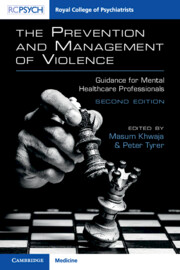Book contents
- The Prevention and Management of Violence
- The Prevention and Management of Violence
- Copyright page
- Dedication
- Contents
- Contributors
- Preface
- Abbreviations
- Section 1 General Aspects of Management
- Section 2 Medical and Psychological Intervention
- Section 3 Violence in Different Settings
- Section 4 Management in Other Groups
- Introduction to Section 4
- Chapter 13 Working With Violence in Children: A Developmental and Relational Perspective
- Chapter 14 Management of Violence in Older Adults
- Chapter 15 Management of Violence in People With Intellectual Disability
- Chapter 16 The Relationship Between Violence and Mental Health Inequality in the Black, Asian and Minority Ethnic Communities
- Section 5 Violence and Society
- Section 6 Engagement and Understanding
- Index
- References
Chapter 13 - Working With Violence in Children: A Developmental and Relational Perspective
from Section 4 - Management in Other Groups
Published online by Cambridge University Press: 09 May 2023
- The Prevention and Management of Violence
- The Prevention and Management of Violence
- Copyright page
- Dedication
- Contents
- Contributors
- Preface
- Abbreviations
- Section 1 General Aspects of Management
- Section 2 Medical and Psychological Intervention
- Section 3 Violence in Different Settings
- Section 4 Management in Other Groups
- Introduction to Section 4
- Chapter 13 Working With Violence in Children: A Developmental and Relational Perspective
- Chapter 14 Management of Violence in Older Adults
- Chapter 15 Management of Violence in People With Intellectual Disability
- Chapter 16 The Relationship Between Violence and Mental Health Inequality in the Black, Asian and Minority Ethnic Communities
- Section 5 Violence and Society
- Section 6 Engagement and Understanding
- Index
- References
Summary
This chapter describes our understanding of violence as pain-based behaviour. We give a comprehensive overview of current best practice, NICE guidelines and research in terms of its conceptualisation, assessment, formulation and treatment, preventive and reactive. We describe the specific considerations that need to be taken into account in working with children, in particular their development, the quality of the relationships and systems around them, legal and ethical issues and principles of child-centred practice. The chapter includes an overview of the current UK provision of services, NHS, secure and otherwise, for children whose distress is communicated through violence, with reference to the recent impact of COVID-19. Finally, we take an organizational perspective, looking at the dynamics aroused in individuals, teams and systems in this sphere of work, and describing theory and research that offers help in working through and resolving the difficulties that arise.
Keywords
- Type
- Chapter
- Information
- The Prevention and Management of ViolenceGuidance for Mental Healthcare Professionals, pp. 202 - 233Publisher: Cambridge University PressPrint publication year: 2023



